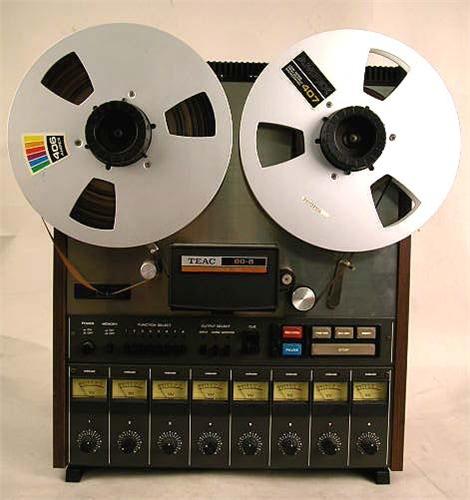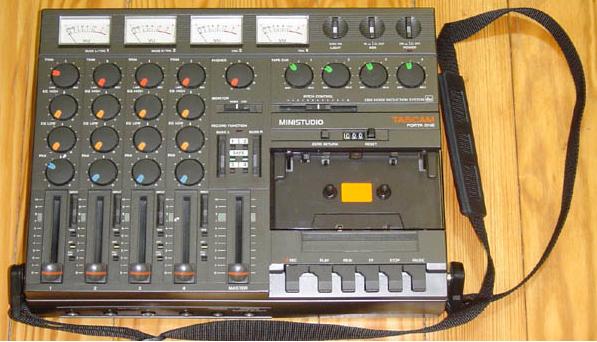|
| JoPo: Thirty years ago, I played drums, percussions & sax but we didn't record, just play. I didn't have enough money to buy a CD player or even to buy all the music I wanted to have. So I went every week in a public media library to take vinyl & CDs and record them on my music system on magnetic tapes. This allowed me to discovered so many music : I didn't like what there was on the radio ! So I'm really happy to live at the time where the technique allows that and mainly to MAKE music at home like Mike Oldfield did by himself... But a numerical studio is not the same price as the Mike Oldfield Analogics one ! Viva el computers! | ||
|
Garyb: My first studio used a Tascam 80-8 1/2" reel to reel. I bought the deck with a Tascam model 1(I believe) mixer. later I upgraded to a model 15 full-frame mixer and a Tascam 30-8. eventually, I moved to a 2" 24track highly modified Scully and a SoundCraft 1600, modified for 24track use. the tape decks sounded great, but, especially the Scully, they needed to be maintained constantly and only about 15 minutes could be recorded to a 10" reel. tape was expensive. the last reel I bought for the Scully was about $140. that was before Ampex went out of business. I also recorded my first "band's" album at home on a rented Otari 1/2" 8 track. when I first for Scope some 15-18 years ago, it was quite a revelation. it sounded darn near as nice as the Scully and was much easier to work with and a lot less expensive to operate. I haven't looked back. I still use the Soundcraft 1600 for microphone pres and for it's monitor section and the TT patch bays in it's frame are still used for outboard. Ronnie: At first I had a Sony 2 track 1/4 inch which I used basically live for my analog equipment. (Rhodes 73, Mini Moog, ARP Odyssey, Solina Strings and Alpha Syntauri in an Apple II-e). I recorded myself live with Drum-Drops on vinyl. The band sessions were done live with two Sony Electret condenser microphones. No compressor, equaliser, only whatever came out of the amps. Gains were set via sound checks. Those tapes sounded pretty good for what they were and I still have most which were done on good tape. One of my never gotten around to projects was to master them in my computer. I have no idea if they would play today even though I picked up a nice TEAC 2 track for the task. There are some great artists on those tapes who later went on to do amazing things, Reuben Hoch and Leslie Ming on Drums, Rick Howard, Dave Lavender and Ira Siegel on guitars, Kashif on keyboards and vocals and (not so great me) on piano, Rhodes and synth pads, leads and bass. No overdubs and since we knew that the takes were really good as I remember. Many originals that I would love to redo one day. When MIDI happened, about a minute later I also had a Tascam 4 track Portastudio. I used 2 tracks for audio, skipping one track away from a track which was used for MIDI sync back and forth from my PC which was running Texture (or Sequencer Plus). Kept the sync track away from the audio because of the crosstalk with a suitably gained sync-signal. The sync went through an OP- 4001 MIDI card and JL Cooper PPS-1. The tape transport was controlled from Texture and everything was MIDI through outboard gear (JX-3P, Casio CZ-101, CZ-1, Yamaha FB-01, Korg Drum Box - no sequencer, just sounds, Korg M1, Korg DSM 1 and EMU racks all controlled by a Roland MKB-300. I forgot the mixer I had but I think it was a Peavey 8 channel through which I patched various Alesis Micro thingies. Reverb, Compressors and a Digitech DSP-128 with an upgraded ROM. These effects also had some MIDI controlled parameters. |
 |
|
|
The MIDI was handled by the PC and did most of the mixing (with hand-made automation!). Occasionally I would bounce on the Portastudio and send the "master" to a rack-mount TASCAM cassette machine. I also want to one day re-master those tracks. MIDI was freedom to compose, master other instruments in their playing techniques and registers. Before sampling, spending hours to perfect strings, horns and whatever, coming up with new sounds. MIDI opened up composition and harmony, orchestration and arranging for me like nothing could. It added afterburners to traverse the entire musical universe at will. Then I got a SCOPE. Luna II. Blown away, I quickly added a Pulsar II and then a Pro. My outboard gear became mostly Roland XV's, A Korg Triton and Yamaha Motif. Sonar and Cubase were the DAWs but everything else was SCOPE for synth, mixing and mastering. The DAW hosted very few VST synths and effects with a Yamaha OV-1 with ADAT basically as motorized faders for SCOPE mixers and a 16 track ADAT interface and some good mikes. A Radikal SAC 2k controlled the DAW (still does) and the Motif and Triton also had ADAT. So here I am, still traversing, with SCOPE still the core and center of my MIDI/studio world, pretty much replacing everything. Measured in years, SCOPE has outlasted everything else by a long-shot. Now with more powerful computers and better VSTs I have some awesome synths (like Diva and PianoTeq and some others from NI, etc.) and convenient effects although SCOPE handles 95% of that without breaking a sweat, especially the reverb, equalizers and mastering. Pretty good VST's have come out like the Korg M-1, CZ-1 and EMU racks, which can load my whatever old patches I still have, along with the Texture and SQ+ MIDI files I still have on that old homebrew 286 Turbo-Tower (8MHz!!!!!) which still boots into DOS and can MIDI in and out and sync both ways with the OP-4001. The original SCOPE Dell Pentium machine lasted over 10 rock-solid years, with 2 CPU - 2.5 and then 3.0 - and RAM - 2 MB and then 4 MB upgrades (for the DAWs) until the boot drive crashed. That machine went from SCOPE 3.1 to 5.0 32 bit. Course now I fondly look back but besides the Roland XV-5050, Motif Rack (and for nostalgic reasons, an EMU-B3, and a Korg DSM-1 which is waiting for the upgrade from JHulk!. I have no outboard gear. No effects either. SCOPE 5.1 does it all on a humble HP XW-4600, Win7 64 2.53 GHz, 16MB RAM with Sonar on top. The OV-1 is also gone (replaced by a BCF2000 for faders) and the SAC 2k still sits on Sonar. The SCOPE cards and SAC 2k are going into their 16th year. The Portastudio went for almost 20 with maintenance but as far as the sound is concerned, there's no comparison. SCOPE can sound like a quarter million dollar studio, but the Portastudio will always sound like, well a cassette - a great cassette with the right tape but still a cassette! If I want, I can make SCOPE sound exactly like a Portastudio but never the other way around. (Don't get me started on Dolby!). JKSuperstar: The absolutely hilarious thing about tape is that a VERY small percentage of the audio production population has heard a tape played on an actual tape machine in the past 10 years, so emulations and comparisons arenít based on anyoneís real experience, just long term memory. Wouterz: Since the early 90ís (I was 16 years old at that time) I own a Kenwood KX-7030 cassette deck (which uses a 3 head system), a Memorex SCT-407 cassette deck and an Akai 4000 DS MK II reel to reel tape recorder which I got for free. I think itís from the 70ís, you can still buy new tapes for it. It also uses a 3 head system so you can use it as a tape echo. I have recorded a lot of (about 200) cassette tapes from the Dutch radio in the 90ís. There was this radio show which played electronic music like the Warp stuff. I digitized most of them I which was a lot of work. In the mid 90ís I recorded my early projects to the Kenwood cassette deck because my computer could not play back MIDI and record audio at the same time. |
||
 |
Nestor: In 1984 I got a Tascam Porta-One, extremely famous little unit in those days. I had it, but did not have a clue of what I was doing when recording, I used it mainly for studying and simply playing around, but trained musicians could achieve pretty amazing masters with the Porta-One. It was something everybody wanted to have. Here it is, this is the exact model I had (left). Dawman: I had more fun with old 4 and 8 tracks. One had to learn to bounce properly or record more instruments simultaneously. I guess buying software is easier and more flexible. I must be getting old though. I notice on Gear Sales threads thereís mostly software instead of hardware. Never imagined selling used 1s and 0s would be so mainstream. I guess the numbers maintain their fidelity over the years. JKSuperstar: Just wait until someone makes an emulator of that one outdated plug-in that 'just nailed the original Fostex sound'. Well I've got a 1/4" Teac 4 track that's collecting dust. Thought maybe I might find a use for it when you start talking about saturation and distortion. Perhaps it could be used on the way into the computer for that or as an external aux? When I was using it I was using it for recording and not really thinking about it as an effect. Of course I'd have to make room for it again and the thing weighs a ton! |
|
|
Dante and PlanetZ Members August 2015 |
|
|